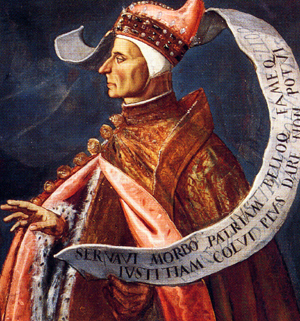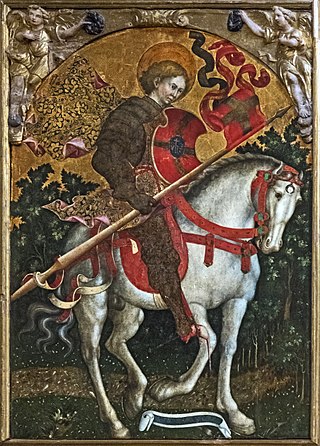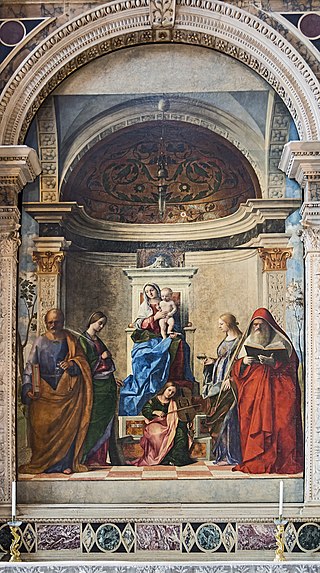
Pala d'Oro (Italian, "Golden Panel") is the high altar retable of the Basilica di San Marco in Venice. It is universally recognized as one of the most refined and accomplished works of Byzantine enamel, with both front and rear sides decorated.

Pala d'Oro (Italian, "Golden Panel") is the high altar retable of the Basilica di San Marco in Venice. It is universally recognized as one of the most refined and accomplished works of Byzantine enamel, with both front and rear sides decorated.

The Pala d'Oro was thought to be first commissioned in 976 by Doge Pietro Orseolo, where it was made up of precious stones and several enamels depicting various saints, and in 1105 it was expanded on by Doge Ordelafo Faliero. [1] In 1345, the goldsmith Giovanni Paolo Bonesegna was commissioned to complete the altarpiece by Andrea Dandolo, who was the procurator at the time, and later became doge. Bonesegna added a Gothic-style frame to the piece, along with more precious stones. [2] Dandolo also included an inscription describing what his own additions were, along with those of his predecessors. [3]
Paolo Veneziano was commissioned to make wood panels to provide a cover (Pala Feriale) for when the altarpiece was not on display. [4] Veneziano was commissioned between 1342-4 to make this cover, where it was dated 1345 and signed by him along with his sons, Luca and Giovanni. [5] The cover is made from two pieces. The top plank features the Man of Sorrows in the center, who is surrounded by the Virgin and Sts. John, George, Mark, Peter, and Nicholas. [5] The bottom plank shows narratives of Life, Martyrdom, Burial, and Translation of St Mark. [5] The wooden panels were opened to the public during liturgies only. In the 15th century, Veneziano's "exterior" altarpiece was replaced by a wooden panel which remains today, though the Pala is now always open.
In 1995, Veneziano's wooden Pala Feriale cover underwent conservation treatment funded by the non-profit organization Save Venice Inc.

The altarpiece is 3 meters (9.8 ft) wide by 2 meters (6.6 ft) tall. [6] It is made of gold and silver, [7] 187 enamel plaques, [5] and 1,927 gems. [2] These include 526 pearls, 330 garnets, 320 emeralds, 255 sapphires, 183 amethysts, 175 agates, 75 rubies, 34 topazes, 16 carnelians, and 13 jaspers. [2]
The altarpiece consists of two parts. The enamels in the top section of the Pala d'Oro contain the Archangel Michael at the center, with six images depicting the Life of Christ on either side of him, which were added in 1209. They show the Entry of Christ into Jerusalem, Descent into Limbo, Crucifixion, Ascension, Pentecost, and Death of the Virgin. [2] It's generally thought that these weren't originally part of the altarpiece, as their stylistic features place them into the 12th century, and they were probably looted during the Fourth Crusade. [8]
The bottom section contains the enamels that told the Life of St. Mark. These were created in 1105 in Constantinople, and were commissioned by Doge Ordelaffo Falier. [9] They used to be positioned along the base, but have since been moved to their current position along the sides and the top row of this section. [9]

Also in the bottom section is an enamel depicting Christ at the center of the altarpiece, and the four circular enamels around him are images of the Four Evangelists. [9] To the right and left of Christ are the twelve apostles, six to each side. Above Christ is an empty throne, which represents the Last Judgement and the Second Coming of Christ, with angels and archangels on either side of it. [3] Underneath Christ and the apostles are the twelve prophets, with the Virgin—flanked by Falier and Empress Irene—at the center. [9]

The two figures surrounding the Virgin are images of Doge Ordelaffo Falier and Byzantine Empress Irene. [10] The depiction of Falier seems to be slightly off as his head is too small in proportion to his body. There is evidence that shows the original head was removed, and replaced with a new one. [10] There are also scratches on the enamel from when the previous head was removed, and some type of wax or paste was used to fill in the gaps where the replacement piece didn't exactly fit. [11]
While there have been theories that the previous head depicted an emperor, that explanation doesn't quite fit. Emperors are usually depicted with red footwear, and this figure is wearing black footwear, with no signs of being altered. [11] Additionally, the enamel bears Falier's name, which would have required a lot of effort to change, and would have left evidence behind. [11] The most likely explanation is that the original head was in fact Falier's head, but without a halo. [11] Later, church officials—possibly even Falier himself—decided to replace it to include a halo. The scepter he's holding restricted how much could be altered, which required the crafters to make the new image slightly smaller. [11]

An altarpiece is an work of art in painting, sculpture or relief representing a religious subject made for placing at the back of or behind the altar of a Christian church. Though most commonly used for a single work of art such as a painting or sculpture, or a set of them, the word can also be used of the whole ensemble behind an altar, otherwise known as a reredos, including what is often an elaborate frame for the central image or images. Altarpieces were one of the most important products of Christian art especially from the late Middle Ages to the era of Baroque painting.

The Patriarchal Cathedral Basilica of Saint Mark, commonly known as St Mark's Basilica, is the cathedral church of the Patriarchate of Venice; it became the episcopal seat of the Patriarch of Venice in 1807, replacing the earlier cathedral of San Pietro di Castello. It is dedicated to and holds the relics of Saint Mark the Evangelist, the patron saint of the city.

Giovanni Bellini was an Italian Renaissance painter, probably the best known of the Bellini family of Venetian painters. He was raised in the household of Jacopo Bellini, formerly thought to have been his father, but now that familial generational relationship is questioned. An older brother, Gentile Bellini was more highly regarded than Giovanni during his lifetime, but the reverse is true today. His brother-in-law was Andrea Mantegna.

Marino Faliero was the 55th Doge of Venice, appointed on 11 September 1354.

The Basilica di Santa Maria Gloriosa dei Frari, commonly abbreviated to the Frari, is a church located in the Campo dei Frari at the heart of the San Polo district of Venice, Italy. It is the largest church in the city and it has the status of a minor basilica. The church is dedicated to the Assumption of Mary.

The Virgin of the Rocks, sometimes the Madonna of the Rocks, is the name of two paintings by the Italian Renaissance artist Leonardo da Vinci, of the same subject, with a composition which is identical except for several significant details. The version generally considered the prime version, the earlier of the two, is unrestored and hangs in the Louvre in Paris. The other, which was restored between 2008 and 2010, hangs in the National Gallery, London. The works are often known as the Louvre Virgin of the Rocks and London Virgin of the Rocks respectively. The paintings are both nearly 2 metres high and are painted in oils. Both were originally painted on wooden panels, but the Louvre version has been transferred to canvas.

Marco Barbarigo was the 73rd Doge of Venice from 1485 until 1486. His nomination took place on a new staircase in the courtyard of the Doge's Palace, on an axis with the Campanile of St. Mark and the Porta della Carta.

Michele Taddeo di Giovanni Bono, known as Giambono was an Italian painter, whose work reflected the International Gothic style with a Venetian influence. He designed the mosaics of the Birth of the Virgin and Presentation in the Temple. His best known paintings are the Man of Sorrows and the St. Peter.

Jacobello del Fiore was a Venetian painter in the late fourteenth century and early fifteenth century. His early work is in the Late Gothic style popularized by Altichiero da Verona and Jacopo Avanzi, two of his contemporaries, while his mature work displays a local Venetian style established by the school of Paolo Veneziano, an artist and workshop proprietor with notable Byzantine inspiration in his work. This stylistic return to his roots sets him apart from Niccolò di Pietro and Zanino di Pietro, Venetian contemporaries he is often associated with. During his lifetime, he received commissions primarily on the Adriatic coast and in Venice.

Paolo Veneziano, also Veneziano Paolo or Paolo da Venezia was a 14th-century painter from Venice, the "founder of the Venetian School" of painting, probably active between about 1321 and 1362. He has been called 'the most important Venetian painter of the 14th century'. His many signed and dated works, some in collaboration with his sons, range between 1333 and 1358. He was regarded as the official painter of the Venetian Republic.

San Francesco della Vigna is a Roman Catholic church in the Sestiere of Castello in Venice, northern Italy.

The Coronation of the Virgin or Coronation of Mary is a subject in Christian art, especially popular in Italy in the 13th to 15th centuries, but continuing in popularity until the 18th century and beyond. Christ, sometimes accompanied by God the Father and the Holy Spirit in the form of a dove, places a crown on the head of Mary as Queen of Heaven. In early versions the setting is a Heaven imagined as an earthly court, staffed by saints and angels; in later versions Heaven is more often seen as in the sky, with the figures seated on clouds. The subject is also notable as one where the whole Christian Trinity is often shown together, sometimes in unusual ways. Crowned Virgins are also seen in Eastern Orthodox Christian icons, specifically in the Russian Orthodox church after the 18th century. Mary is sometimes shown, in both Eastern and Western Christian art, being crowned by one or two angels, but this is considered a different subject.
Giovanni d'Alemagna was a Venetian renaissance painter of German ancestry, active in Italy, with his brother-in-law Antonio Vivarini on religious paintings in Venice and Padua, that are preserved in the named cities together with those of Vivarini.

The Stefaneschi Altarpiece is a triptych by the Italian painter Giotto, from c. 1320. It was commissioned by Cardinal Giacomo Gaetani Stefaneschi to serve as an altarpiece for one of the altars of Old St. Peter's Basilica in Rome. It is now at the Pinacoteca Vaticana, in Rome.

The Santa Lucia de' Magnoli Altarpiece is a painting by the Italian painter Domenico Veneziano, dated to around 1445–1447. Once placed at the high altar of the church of Santa Lucia dei Magnoli, Florence, it is now in the Uffizi Gallery in the same city. The large panel had originally a predella, which has been divided between museums in Washington, Berlin and Cambridge.

The Barbadori Altarpiece is a painting by Filippo Lippi, dated to 1438 and housed in the Louvre Museum of Paris.

The San Zaccaria Altarpiece is a painting by the Italian Renaissance painter Giovanni Bellini, executed in 1505 and located in the church of San Zaccaria, Venice.

The San Giobbe Altarpiece is a c. 1487 altarpiece in oils on panel by the Venetian Renaissance painter Giovanni Bellini. Inspired by a plague outbreak in 1485, this sacra conversazione painting is unique in that it was designed in situ with the surrounding architecture of the church, and was one of the largest sacra conversazione paintings at the time. Although it was originally located in the Church of San Giobbe, Venice, it is now in the Gallerie dell'Accademia in Venice after having been stolen by Napoleon Bonaparte.

The church of San Luca Evangelista is a church in the sestiere of San Marco in Venice, Italy.

The Treasury of St Mark's Basilica contains the church treasure or collection of sacred objects and reliquaries kept in St Mark's Basilica in Venice, Italy. The treasure constitutes the single best collection of Byzantine metalwork and enamels that survives, many of the items having been looted during the Fourth Crusade of 1204. The treasury also contains some significant artworks made for the basilica itself, but no longer used there.